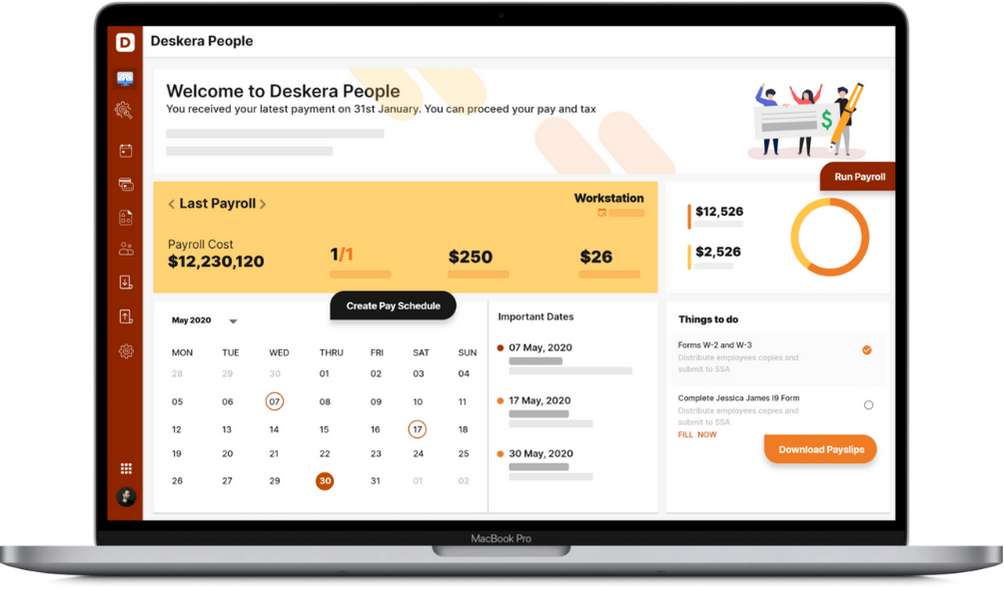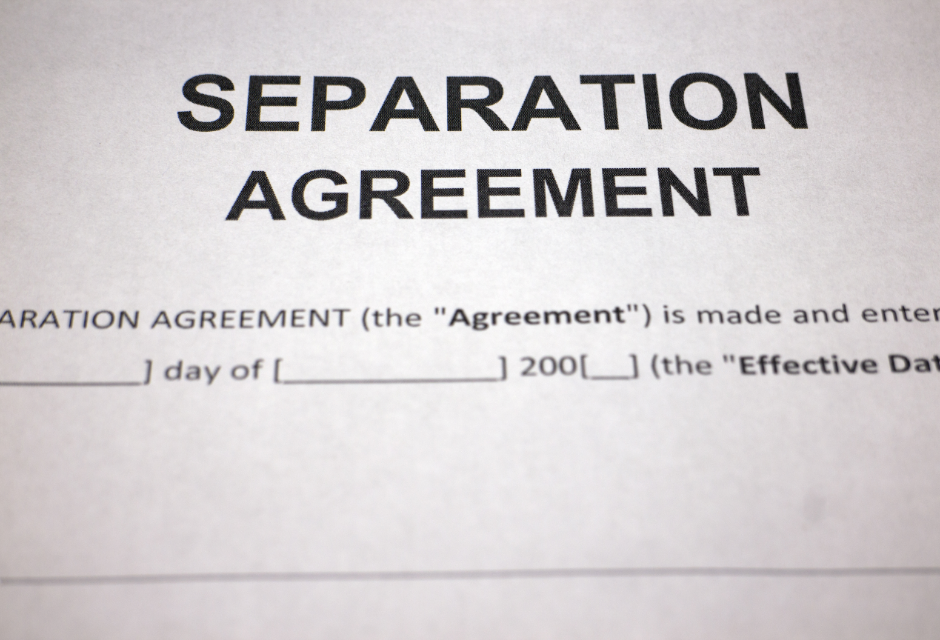How is the new hire welcome process in your company? What’s the onboarding process like? Are you trying to meet their needs when the new hire is trying to integrate into the team?
Good managers acknowledge that understanding and addressing the needs and well-being of team members is critical to building productive and highly successful teams. Maslow’s hierarchy of onboarding displays the journey from a new hire to a resourceful employee.
Here is what more we shall learn about the dynamics involved in Maslow’s hierarchy chart with respect to the onboarding procedure:
- A Small Piece of Background
- What is Maslow’s Hierarchy of Needs?
- Why does Onboarding Experience matter?
- Maslow's Hierarchy And Employee Engagement
- Why is it essential to pay attention to your employees?
- How can Deskera Help You?
- Key Takeaways
A Small Piece of Background
The Hierarchy of Needs, developed by Abraham Maslow, was an early and significant concept in this discipline. When your employees realize you're treating them well, they'll want to give their all in return. On the other hand, if you overlook your team's requirements, they will become demotivated or disengaged. They might even decide to leave.
It was first published in 1943 in his paper ‘A Theory of Human Motivation’ and later popularized in his 1954 book "Motivation and Personality. To date, the concept has been used to motivate employees to come up with outstanding performance.
Earlier, the counselors were often critical about the way things worked that involved employees. They were criticized for the things that did not happen as intended, for the goals that could not be met, for the deadlines that got overstepped, and so on. The overall effort of the employee was overlooked more often than not. It was only around the late 1950s, that they began to think more positively about them. Today, employers have gradually embraced more collaborative methods since then to identify the contributing members and reward the deserving ones.
When we get to know the elements such as Maslow’s hierarchy, it becomes clearer why things have changed for the good. The various strata described in the hierarchy vividly explain each terminology that is relevant to the employee onboarding process. In view of this, the new employee onboarding process has become much quirkier and more interesting for all, especially the new joiner.
What is Maslow’s Hierarchy of Needs?
According to Maslow's hypothesis, as individuals continue to attain their most fundamental needs, they also aspire to meet a higher set of demands until they reach self-actualization. It is all about the profound purpose in life and the excellence one wants to achieve. We have tried to break down the theory in a way to understand how it applies in the employee onboarding process.
First, we will cover the human needs in a broad way to look at the various aspect each level of the triangle highlights. In the sections after that, we shall understand how they work in alignment with the onboarding tasks.
So, what exactly are the human needs that Maslow’s hierarchy talks about?
Let’s get a glimpse of the hierarchy in brief before we are en route to obtaining the deeper meaning of the term in the oncoming sections. It entails the motivating needs that include:
- Physiological or physical needs
These are the very basic or the primary needs of an individual. They include the biological needs that include food, water, shelter, sleep, clothing, and so on. Without these primary factors, it would be impossible for a human to perform or survive. The physiological needs are the ones that are extremely important for an individual’s survival.
2. Security and safety needs
Once the physiological needs are fulfilled, next comes the safety requirements. People are basically looking at protecting themselves and taking control of the things around them.
3. Love and belonging needs
This is about interpersonal relationships, love, and belonging. Friendships, family, trust are some of the emotions a person looks for, here.
4. Esteem needs
This fourth level of the pyramid is for esteem needs. Feelings like independence, dignity, or any personal achievement are included here.
5. Self-actualization needs
This level is all about what one thinks they are capable of achieving. It describes self-fulfillment, peak experiences, and personal growth.
The pyramid works as a guide to help you understand your employee’s mindsets, their needs, and how you can work to achieve their needs.
Why does Onboarding Experience matter?
Everyone has memories of the day they were onboarded. These memories keep gnawing in their minds for weeks and also tend to affect their work in the company. To sum up, they have already created a first impression about the company they are working for.
Good or not so good, employees hold on to these first impressions for too long; and therefore, it is crucial to make these their best ones. After all, happy employees are at their productive best.
We give you 7 reasons why a good onboarding experience matters to businesses:
The first perception of your firm a new employee has might lead the way for their potential performance in the future. Seize the opportunity to ensure that your new hires feel appreciated, safe, and satisfied in their new positions.
As observed from the table above, an exceptional onboarding process is advantageous for the employer and the employees. There is no gap for any kind of miscommunication and therefore, also offers clarity to the new hire about the roles and responsibilities they will be handling.
Then, the employees that are well connected find themselves in better spots when making decisions and in their overall performance. A better employee engagement also results in higher profitability for the business. Apart from these, the hiring managers have access to a variety of best practices, templates, and guides that make onboarding a smooth drive.
From the sections seen so far, we have a basic understanding of the various levels of Maslow’s pyramid and why onboarding plays a pivotal role. Now, we can move on to getting a grip on how it applies to the area of employee engagement.
Maslow's Hierarchy And Employee Engagement
Maslow’s theory explains how the five-level ladder is crucial for tracking the development and performance of humans. The same ideas could be used to describe and follow employee engagement.
Physiological Needs
At the first level, Maslow highlights the importance of physiological requirements. The tools and knowledge needed to complete a task are an employee's physiological needs. This level is crucial for progressing to the next phases and should not be disregarded. The new hires are generally at a disengaged level when they are in the initial stages of attending office. An uninterested employee may be the one who is underperforming and thus, indicates being entrenched at the bottom of the pyramid.
Studies have shown that the new hires tend to stay longer with their companies if they had a great onboarding experience. Some of the examples of ways to achieve this pyramid level are as follows:
Even in the face of wage cuts, organizations should make an extra effort to focus on employee health and guarantee that basic necessities such as food, rent, and other living expenses are met. Be approachable and make the employee feel that they can communicate their discomfort at any time.
All you have to do is streamline your tasks to keep the employee agenda as a priority. Employers must keep a constant eye on reading the employee behavior in terms of physiological needs and provide reassurance when needed. After all, it doesn't have to be difficult to meet your employees' physiological demands!
Meeting these basic necessities gives a clear roadmap to the next stage that necessitates a strong onboarding program. A nicely chalked-out program can reduce the employee's time at work and enhance productivity. Moreover, it will simultaneously create opportunities for them to speak up when they need to. Offer them the necessary training.
Safety
There was a time around the great recession when people were extremely anxious about job security. However, times have changed now, and how! People no longer have to bother about job security as much as they had to, in earlier times.
With a large number of workers emphasizing work-life balance, safety for the present worker means having support for families and couples. Leaving space for mishaps and tragedies is also one of their top priorities for them. They also want to be able to take time off for short vacations and holidays with their families.
Studies reveal that almost 65% of people would love to have paid family leave. Furthermore, a lot of employees also desire a remote working facility. We know how COVID has paved the way for remote working; even in the sectors which considered only physical presence as a mode of working.
Next comes the benefits that the employees look forward to receiving from the employers. This includes the various retirement plans, Health Reimbursement Arrangements, and so on. It has been studied that approximately 55% of employees get attracted to jobs that offer these benefits. It gives them a sense of security as far as the medical bills are concerned. These benefits also allow them to take care of the medical needs of their family members more diligently.
Love and Belonging
When you are welcoming a new person to the team, it becomes significant that they are being made to feel comfortable. Unless they have a sense of belonging to the team, they may not come up with the best effort. In the process when you are introducing them, attempt to make it a bit casual so that the awkwardness subsides sooner. A short warm welcoming celebration can help them feel a part of the team and make them feel special.

Here are some quick tips that can lead the way forward for you:
- Balloons and cards are some of the sweetest ways in which you can decorate the desk of the new team member and cheer things up for them. This gesture could become memorable for them.
- You can directly introduce them in person to the key people they must know. The personal introductions as compared to the digital ones fare far better in terms of making things easy for the new members.
- If you are looking for an effective ice-breaker between your team members, then sending a company-wide mail could do the trick. Adding some interesting facts about the new hire could not only be interesting for all to know but also let the new one feel important.
- As an extended part of the above point, you can also add what makes the new member unique. Also, state their outstanding qualities or previous achievements. When they start working with their new team, it could be a great point for discussion, thus harmonizing the entire team.
- Aside from these aspects, you could also introduce them to an experienced employee who could help them out in times of the initial glitches that every new employee is prone to. As a result, they are bound to get a cozy and snug atmosphere that is very welcoming.
It is all about showing love, acceptance, and hospitality. Easy ways to do this are by decorating their desk, introducing them to the fun ways to unwind at the office such as the coffee machine, the table tennis area, the library section, and so on.
Self-esteem
You know you want to raise a team that can eventually work independently. Therefore, it is essential to build confidence and Self-esteem in all your employees right from the time they join.
Once they are through the initial stages of introduction and meetings, now you can gauge if they are confident enough and show signs of responsibility. The ones you think need a little coaxing can be guided.

However, your focus should be on the candidates that have exhibited confidence, esteem, and accountability. They can be encouraged to take up new projects and can be motivated to strive harder and produce greater work.
Employees in the fourth stage want to be appreciated for their efforts. Employee engagement necessitates praise and positive feedback from coworkers and management
According to Maslow, all these needs are vital to keeping intact the mental health of individuals. When people's needs aren't met, their mental health suffers, which has an impact on their general well-being. When employees' hierarchical needs aren't met, they exhibit low levels of employee engagement. This has a significant impact on staff enthusiasm, output, and employment.
In all, acknowledging and appreciating are the key points here. Surveys show that nearly 70% of employees resign from their jobs due to a lack of recognition, acknowledgment, and appreciation. Ensure that you have noticed the worthy employees. They must be acknowledged for their hard work and praised when due. Rewarding and recognizing are crucial for meeting employees’ needs.
Self-Actualization
This is the peak of the pyramid. At this stage, an individual is in a state of comfort as far as physiological needs, safety, love, and self-esteem are concerned. However, the people in this stage are persistent about achieving higher ground and the best possible career path. We can say that every employee desires to attain self-actualization, and if an organization or a manager helps them accomplish it, the employees are more likely to stay with them.
- Employees that wish to increase their effect and aptitude to influence and encourage are at the last stage, self-actualization
- Employees that are self-actualized feel stimulated and motivated in their jobs and have a chance to advance and flourish
- They are also inspired to work towards the accomplishment of a larger goal that benefits the organization

At this stage, you or the organization can facilitate an environment that provides scope for the employee to grow. The Employees are content with how the company has helped them achieve their personal and professional goals, and now they are motivated enough to accelerate their mechanisms and steer the company and their team towards better victories.
The individuals here are characterized by an innate ability to think beyond the obvious and keep innovating their thought processes. They have a constant ambition to grow and help the company expand, too. On the manager’s part, it is vital to identify such talent and hone their skills. They must direct their workforce to arrive at this stage as it not only works well for the employees but also for the organization.
Why is it Essential to Pay Attention to your Employees?
It is important to collect employee feedback and know what their views are about the various aspects of their employment and the organization, as a whole. Let employees have a chance to let out their thought about the processes that affect them in the organization.
During the pandemic, meeting employee requirements is especially more important. There's only a minuscule percentage of employees that agree that their HR department knows what they need and desire, according to research. If such a situation arises, the managers should begin taking cognizance of the staff and their requirements.
Companies can facilitate anonymous feedback so that the employees share their thoughts without any inhibitions. Their thoughts and expressions should be utilized to further improve the working conditions and to make them feel more comfortable at the workplace.
All these factors together contribute to persuading the new employees to believe in the idea of your organization and dedicate themselves to taking it from one height to the other!
How can Deskera Help You?
Deskera People allows you to conveniently manage leave, attendance, payroll, and other expenses. Generating pay slips for your employees is now easy as the platform also digitizes and automates HR processes.

Key Takeaways
Abraham Maslow's Hierarchy of Needs was an early and influential notion in this field. When your employees see how nicely you treat them, they'll want to return the favor. Let’s quickly run through the points we saw in the article.
- Maslow’s hierarchy of onboarding displays the journey from a new hire to a resourceful employee
- According to Maslow's hypothesis, as individuals continue to attain their most fundamental needs, they also aspire to meet a higher set of demands until they reach self-actualization
- Physiological or physical needs are the very basic or the primary needs of an individual
- With Security and safety needs, people, in general, are looking at protecting themselves and taking control of the things around them
- The stratum of love and belonging highlights the importance of family, friendships, and trust
- Feelings like independence, dignity, or any personal achievement are included under Self-esteem element of the pyramid
- Self-actualization is all about what one thinks they are capable of achieving. It describes self-fulfillment, peak experiences, and personal growth
- Eliminating miscommunication, clarity about the roles and responsibilities, positive work environment are some of the benefits of investing in an onboarding process
- Physiological needs under employee onboarding include paying employees on time, offering a hassle-free mode of communication
- Safety under employee onboarding includes offering work-life balance, financial and medical benefits
- Love and belonging under employee onboarding includes showing love and acceptance. This can be done by decorating their desk, introducing them to the fun ways to unwind at the office such as the coffee machine, the table tennis area, the library section, and so on
- Self-esteem under employee onboarding include rewarding and recognizing employees. They must be acknowledged for their hard work and praised when due
- Employees that wish to increase their effect and aptitude to influence and encourage are at the last stage, self-actualization
Related Articles















